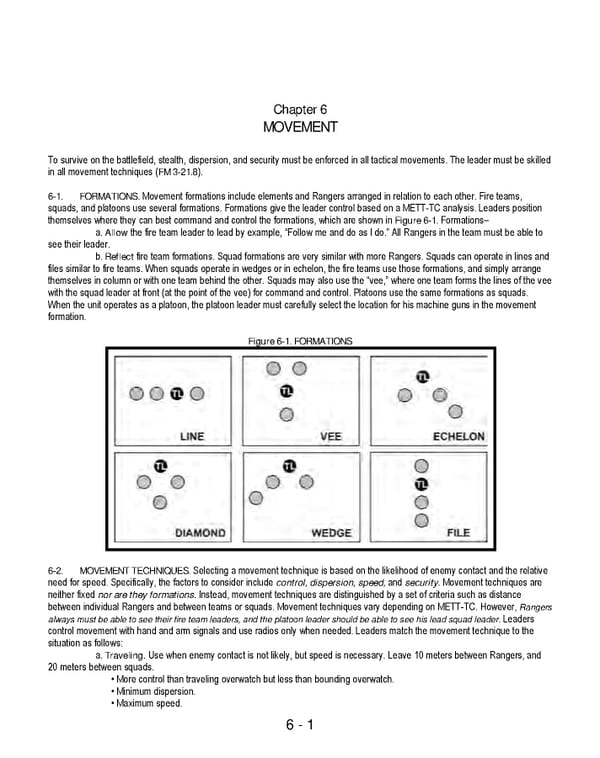6 - 1 Chapter 6 MOVEMENT To survive on the battlefield, stealth, dispersion, and security must be enforced in all tactical movements. The leader must be skilled in all movement techniques (FM 3-21.8). 6-1. FORMATIONS. Movement formations include elements and Rangers arranged in relation to each other. Fire teams, squads, and platoons use several formations. Formations give the leader control based on a METT-TC analysis. Leaders position themselves where they can best command and control the formations, which are shown in Figure 6-1. Formations– a. Allow the fire team leader to lead by example, “Follow me and do as I do.” All Rangers in the team must be able to see their leader. b. Reflect fire team formations. Squad formations are very similar with more Rangers. Squads can operate in lines and files similar to fire teams. When squads operate in wedges or in echelon, the fire teams use those formations, and simply arrange themselves in column or with one team behind the other. Squads may also use the “vee,” where one team forms the lines of the vee with the squad leader at front (at the point of the vee) for command and control. Platoons use the same formations as squads. When the unit operates as a platoon, the platoon leader must carefully select the location for his machine guns in the movement formation. Figure 6-1. FORMATIONS 6-2. MOVEMENT TECHNIQUES. Selecting a movement technique is based on the likelihood of enemy contact and the relative need for speed. Specifically, the factors to consider include control, dispersion, speed, and security. Movement techniques are neither fixed nor are they formations. Instead, movement techniques are distinguished by a set of criteria such as distance between individual Rangers and between teams or squads. Movement techniques vary depending on METT-TC. However, Rangers always must be able to see their fire team leaders, and the platoon leader should be able to see his lead squad leader. Leaders control movement with hand and arm signals and use radios only when needed. Leaders match the movement technique to the situation as follows: a. Traveling. Use when enemy contact is not likely, but speed is necessary. Leave 10 meters between Rangers, and 20 meters between squads. • More control than traveling overwatch but less than bounding overwatch. • Minimum dispersion. • Maximum speed.
 Ranger Handbook Page 100 Page 102
Ranger Handbook Page 100 Page 102